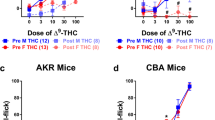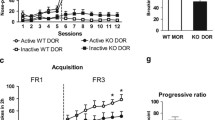Abstract
Rationale
Pharmacological manipulations of the type 1 cannabinoid receptor (CB1) suggest a role for CB1 in morphine-induced antinociception, but studies utilizing CB1 knockout (KO) mice do not support this conclusion. Since studies using CB1 KO mice to study morphine’s antinociceptive effects have only examined thermal nociception, this study examines these interactions in models that employ a chemical stimulus.
Objectives
To determine whether the findings obtained with thermal pain models extend to other models, the effects of morphine on acetic acid-induced writhing were examined in CB1 KO and wildtype (WT) mice. Behaviors that decrease in response to acid injection, feeding and wheel running, were also examined, and investigations were carried out in the thermal hotplate assay. The CB1 antagonist SR141716A was also examined in these assays.
Results
Morphine completely blocked acid-induced writhing (1.0–10.0 mg/kg) and increased response latencies in the hotplate (10.0–32.0 mg/kg) in both genotypes. Morphine (3.2 mg/kg) significantly attenuated the suppression of wheel running but did not completely prevent this effect in either genotype. Morphine did not alter pain-suppressed feeding. In each of these assays, morphine’s effects were not altered in CB1 KO mice compared with WT mice; however, SR141716A attenuated morphine’s effects in C57BL/6 mice.
Conclusions
The effects of morphine do not differ in CB1 KO and WT mice in preclinical pain models using thermal and chemical stimuli. Since SR141716A did attenuate the effects of morphine, it is possible that CB1 KO mice undergo developmental changes that mask the role of CB1 receptors in morphine’s antinociceptive effects.








Similar content being viewed by others

References
Ates M, Hamza M, Seidel K, Kotalla CE, Ledent C, Guhring H (2003) Intrathecally applied flurbiprofren produces an endocannabinoid-dependent antinociception in the rat formalin test. Eur J Neurosci 17:597–604
Booker L, Naidu PS, Razdan RK, Mahadevan A, Lichtman AH (2009) Evaluation of prevalent phytocannabinoids in the acetic acid model of visceral nociception. Drug Alcohol Depend 105:42–47
Calignano A, La Rana G, Giuffrida A, Piomelli D (1998) Control of pain by endogenous cannabinoids. Nature 394:277–281
Cichewicz DL, McCarthy (2003) Antinociceptive synergy between Δ9-tetrahydrocannabinol and opioids after oral administration. J Pharmacol Exp Ther 304: 1010–1015
Cota D, Marsican G, Tschop M, Grubler Y, Flachskamm C, Schubert M, Auer D et al (2003) The endogenous cannabinoid system affects energy balance via central orexigenic drive and peripheral lipgenesis. J Clin Invest 112:423–431
Cox ML, Welch SP (2004) The antinociceptive effect of Delta-9-tetrahydrocannabinol in the arthritic rat. Eur J Pharmacol 493:65–84
Cox ML, Haller VL, Welch SP (2007) Synergy between Δ9-tetrahydrocannabinol and morphine in the arthritic rat. Eur J Pharmacol 567:125–130
Cravatt BF, Demarest K, Patricelli MP, Bracey MH, Giang DK, Martin BR, Lichtman AH (2001) Supersensitivity to anandamide and enhanced endogenous cannabinoid signaling in mice lacking fatty acid amide hydrolase. PNAS 98:9371–9376
Diaz S, Farhang B, Hoien J, Stahlman M, Adatia N, Cox JM, Wagner EJ (2009) Sex differences in the cannabinoid modulation of appetite, body temperature and neurotransmission at POMC synapses. Neuroendocrinology 89:424–440
Dubreucq S, Koehl M, Abrous DN, Mariscano G, Chaouloff F (2010) CB1 receptor deficiency decreases wheel-running activity: consequences on emotional behaviours and hippocampal neurogenesis. Exp Neurol. doi:10.1016/j.expneurol.2010.01.017
Haller VL, Stevens DL, Welch SP (2008) Modulation of opioids via protection of anandamide degradation by fatty acid amide hydrolase. Eur J Pharmacol 600:50–58
Institute of Laboratory Animal Research, Division on Earth and Life Studies, National Research Council (2010) Guide for the care and use of laboratory animals. National Academy, Washington
Jarbe TU, DiPatrizio NV (2005) Delta9-THC induced hyperphagia and tolerance assessment: interactions between the CB1 receptor agonist delta9-THC and the CB1 receptor antagonist SR-141716 (rimonabant) in rats. Behav Pharmacol 16:373–380
Justinova Z, Munzar P, Panlilio LV, Yasar S, Redhi GH, Tanda G, Goldberg SR (2008) Blockade of THC-seeking behavior and relapse in monkeys by the cannabinoid CB(1)-receptor antagonist rimonabant. Neuropsychopharmacol 33:2870–2877
Keeney BK, Raichlen DA, Meek TH, Wijeratne RS, Middleton KM, Gerdeman GL, Garland TJ (2008) Differential responses to a selective cannabinoid receptor antagonist (SR141716: rimonabant) in female mice from lines selectively bred for high voluntary wheel-running behavior. Behav Pharmacol 19:812–820
Li D, Olszewski PK, Shi MK, Billington CJ, Kotz CM, Levine AS (2006) Effect of opioid receptor ligands injected into the rostral lateral hypothalamus on c-fos and feeding behavior. Brain Res 1096:120–124
Le Bars D, Gozariu M, Cadden SW (2001) Animal models of nociception. Pharmacol Rev 53:597–692
Ledent C, Valverde O, Cossu G, Petetet F, Aubert JF, Beslot F et al (1999) Unresponsiveness to cannabinoids and reduced addictive effects of opiates in CB1 receptor knockout mice. Science 283:401–404
Martin TJ, Zhang Y, Buechler N, Conklin DR, Eisenach JC (2005) Intrathecal morphine and ketorlac analgesia after surgery: comparison of spontaneous and elicited responses in rats. Pain 113:376–385
Mason DJ, Lowe J, Welch SP (1999) A diminution of delta9-tetrahydrocannabinol modulation of dynorphin A-(1–17) in conjunction with tolerance development. Eur J Pharmacol 381:105–111
Matson DJ, Broom DC, Carson SR, Baldassari J, Kehne J, Cortright DN (2007) Inflammation-induced reduction of spontaneous activity by adjuvant: a novel model to study the effect of analgesics in rats. J Pharmacol Exp Ther 320:194–201
Miller CC, Murray TF, Freeman KG, Edwards FG (2004) Cannabinoid agonst, CP 55940, facilitates intake of palatable foods when injected into the hindbrain. Physiol Behav 80:611–616
Mogil JS (2009) Animal models of pain: progress and challenges. Nat Rev Neurosci 10:283–294
Naidu PS, Booker L, Cravatt BF, Lichtman AH (2009) Synergy between enzyme inhibitors of fatty acid amide hydrolase and cyclooxygenase in visceral nociception. J Pharmacol Exp Ther 329:48–56
Negus SS, Rice KC (2009) Mechanisms of withdrawal-associated increases in heroin self-administration: pharmacological modulation of heroin vs food choice in heroin-dependent rhesus monkeys. Neuropsychopharmacol 34:899–911
Negus SS, Morrissey EM, Rosenberg M, Cheng K, Rice KC (2010) Effects of kappa opioids in an assay of pain-depressed intracranial self-stimulation in rats. Psychopharmacology. doi:10.1007/s00213-009-1770-6
Pacheco DF, Klein A, Perez AC, Pacheco CMF, Francischi JN, Duarte ID (2008) The mu-opioid receptor agonist morphine, but not agonists at delta- or kappa-opioid receptors, induces peripheral antinociception mediated by cannabinoid receptors. Brit J Pharmacol 154:1143–1149
Pacheco DF, Klein A, Perez AC, Pacheco CMF, Francischi JN, Reis GML, Duarte IDG (2009) Central antinociception induced by μ-opioid receptor agonist morphine, but not δ- or κ- is mediated by cannabinoid CB1 receptor. Brit J Pharmacol 158:225–231
Pascual D, Goicoechea C, Suardiaz M, Martin MI (2005) A cannabinoid agonist, WIN 55, 212–2, reduces neuropathic nociception induced by paclitaxel in rats. Pain 118:23–34
Pereira Do Carmo G, Stevenson GW, Carlezon WA, Negus SS (2009) Effects of pain- and analgesia-related manipulations on intracranial self-stimulation in rats: further studies on pain-depressed behavior. Pain 144:170–177
Pertwee RG (2006) The pharmacology of cannabinoid receptors and their ligands: an overview. Int J Obes 30:S13–S18
Richardson JD, Kilo S, Hargreaves KM (1998) Cannabinoids reduce hyperalgesia and inflammation via interaction with peripheral CB1 receptors. Pain 75:111–119
Smith MA, Greene-Naples JL, Lyle MA, Iordanou JC, Felder JN (2009) The effects of repeated opioid administration on locomotor activity: I. Opposing actions of μ and κ receptors. J Pharmacol Exp Ther 330:468–475
Stevenson GW, Bilsky EJ, Negus SS (2006) Targeting pain-suppressed behaviors in preclinical assays of pain and analgesia: effects of morphine on acetic acid-suppressed feeding in C57Bl/6J mice. J Pain 7:408–416
Stevenson GW, Cormier J, Mercer H, Adams C, Dunbar C, Negus SS, Bilsky EJ (2009) Targeting pain-depressed behaviors in preclinical assays of pain and analgesia: drug effects on acetic acid-depressed locomotor activity in ICR mice. Life Sci 85:309–315
Valverde O, Ledent C, Beslot F, Parmentier M, Roques BP (2000) Reduction of stress-induced analgesia but not of exogenous opioid effects in mice lacking CB1 receptors. Eur J Neurosci 12:533–539
Vigano D, Valenti M, Cascio MG, Di Marzo V, Parolaro D, Rubino T (2004) Changes in endocannabinoid levels in a rat model of behavioral sensitization. Eur J Neurosci 20:1849–1857
Viganò D, Rubino T, Vaccani A, Bianchessi S, Marmorato P, Castiglioni C, Parolaro D (2005) Molecular mechanisms involved in the asymmetric interaction between cannabinoid and opioid systems. Psychopharmacol Berl 182:527–536
Waldhoer M, Bartlett SE, Whistler JL (2004) Opioid receptors. Annu Rev Biochem 73:953–990
Wang Y, Guo J, Wang S, Fang Q, He F, Wang R (2009) Neuropeptide FF receptors antagonist, RF9, attenuates opioid-evoked hypothermia in mice. Peptides 29:1183–1190
Ward SJ, Lefever TW, Rawls SM, Whiteside GT, Walker EA (2009) Age-dependent effects of the cannabinoid CB1 antagonist SR141716A on food intake, body weight change, and pruritus in rats. Psychopharmacology 206:155–165
Zimmer A, Zimmer AM, Hohmann AG, Herkenham M, Bonner TI (1999) Increased mortality, hypoactivity, and hypoalgesia in cannabinoid CB1 receptor knockout mice. Proc Natl Acad Sci 96:5780–5785
Acknowledgments
The authors thank Dr. Steve Negus for his important comments and advice prior to the initiation of these studies.
Author information
Authors and Affiliations
Corresponding author
Additional information
Supported by NIH grants R01-DA002749, T32-007244, and F31-DA025446.
Rights and permissions
About this article
Cite this article
Miller, L.L., Picker, M.J., Schmidt, K.T. et al. Effects of morphine on pain-elicited and pain-suppressed behavior in CB1 knockout and wildtype mice. Psychopharmacology 215, 455–465 (2011). https://doi.org/10.1007/s00213-011-2232-5
Received:
Accepted:
Published:
Issue Date:
DOI: https://doi.org/10.1007/s00213-011-2232-5



